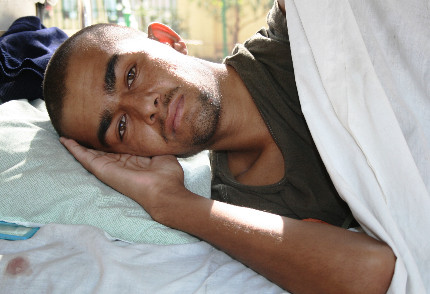The war in Afghanistan shows no sign of abating and conflict-related misery such as internal displacement, lack of access to essential health services and civilian casualties, is set to rise in 2011, aid agencies and analysts warn.

Wounded in conflict at an ICRC hospital in Kabul. (Photo: Akmal Dawi/ IRIN)
“We are growing increasingly concerned about the conflict, which is into its ninth year. It’s spreading and intensifying and we’re [likely] to see another year of conflict with dramatic consequences for civilians,” Reto Stocker, president of the International Committee of the Red Cross (ICRC) office in Afghanistan, said on 15 December.
Civilian deaths and injuries resulting from the conflict have continued to rise over the past two years and civilian communities have been forced to take sides in the war, the organization said.
“Mirwais Regional Hospital in Kandahar, serving around four million people, has admitted over 2,650 weapon-related patients so far in 2010, compared with just over 2,110 in 2009,” the ICRC said.
In the first six months of 2010, the UN Assistance Mission in Afghanistan (UNAMA) reported 3,268 civilian casualties (1,271 deaths and 1,997 injuries) - up 31 percent on the same period a year ago.
With more than 1,750 staff in 15 local offices, Afghanistan is the ICRC’s largest operation worldwide, with a budget of US$89 million to assist conflict-affected people in 2011.
More than money needed
In a humanitarian appeal launched on 5 December, 51 international and local aid agencies requested $678 million to assist the most vulnerable people in Afghanistan in 2011 through 134 projects.
The appeal expects the number of internally displaced persons (IDPs) to increase from 320,000 in 2010 to 440,000 in 2011.
“The toll of ongoing conflict and endemic natural disasters on Afghanistan’s people remains immense, requiring continued life-saving assistance,” Catherine Bragg, the UN Deputy Emergency Relief Coordinator and Assistant Secretary-General for Humanitarian Affairs, told reporters at the launch of the appeal.
However, money alone is not enough for aid agencies to save lives in Afghanistan. Access to people in insecure areas and immunity from attacks and intimidation are other key requirements.
More than half the country, including some of the worst conflict-affected areas, is inaccessible to UN agencies and other international aid organizations.
While deliberate armed attacks on humanitarian workers not perceived as aligned to military and political actors have shrunk steadily over the past year, according to the Afghanistan NGO Safety Office, the ICRC is increasingly concerned about the proliferation of armed actors, which often inhibit humanitarian work and pose serious risks to civilians.
“I think the critical test will be in spring 2011,” Ahmed Rashid, a Pakistani journalist and author of The Taliban, told IRIN.
“If we are going to see a resurgence in the Taliban violence in 2011 as we saw in 2010, then I think the whole situation will become very, very serious.”
Matt Waldman, an independent Afghanistan analyst, said more civilian Afghans would be caught up in the intensified conflict next year.
“All the evidence suggests that NATO's military escalation is more than matched by the Taliban,” he said, adding that conditions could only improve if there is political reform and a multi-layered peace process with the Taliban, which should be backed by the US.
“Neither can happen too soon,” Waldman said.



